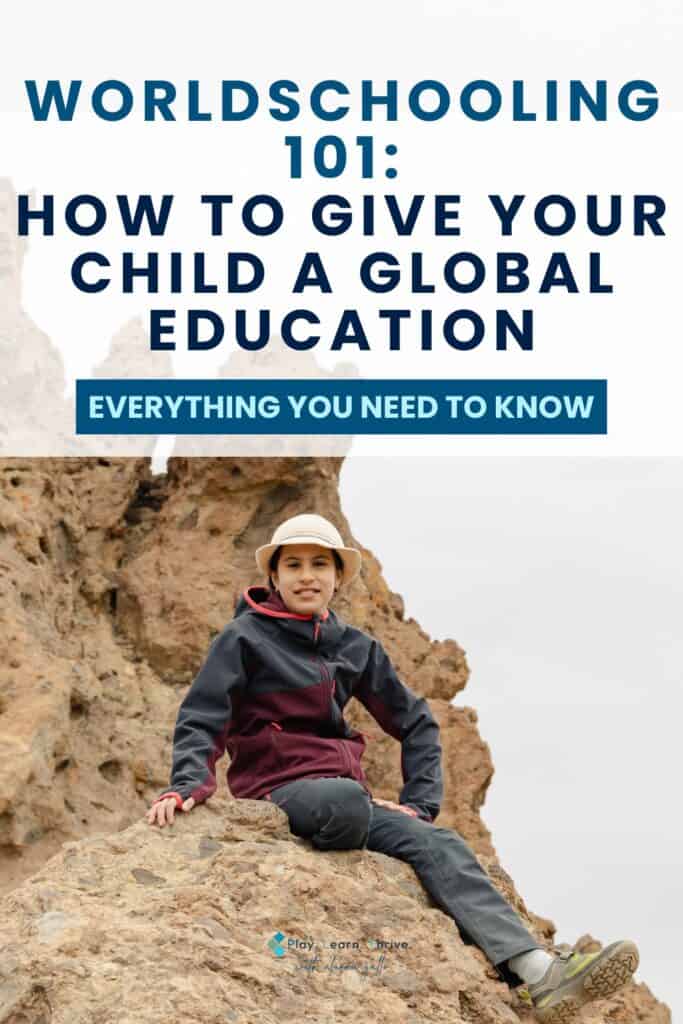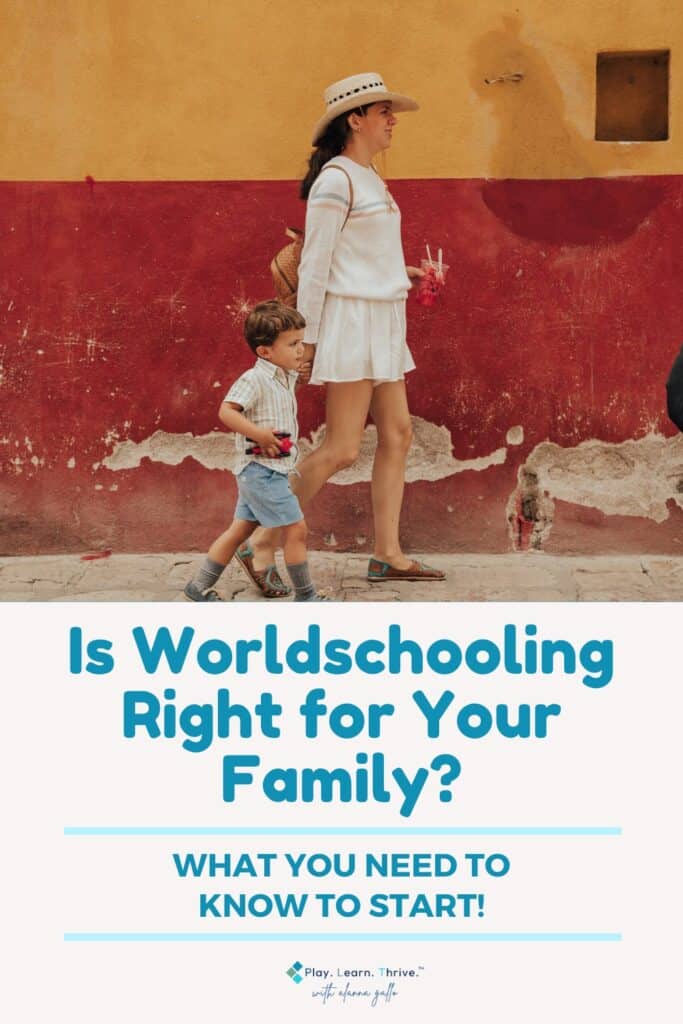Worldschooling 101: How to Give Your Child a Global Education
In today’s interconnected world, the classroom extends far beyond four walls. Worldschooling is an exciting approach to education that allows children to learn through travel, exploring new cultures, languages, and histories firsthand.

Play. Learn. Thrive.™ only endorses products we authentically love and use. Some of the product links in this post may be affiliate links. That means that if you click them and make a purchase, this site makes a commission. Play. Learn. Thrive.™ is also an Amazon Associate. As an Amazon Associate, we earn from qualifying purchases. It will have no impact on the price you pay or the experience of your purchase.
Imagine your child learning about ancient civilizations while exploring the ruins of Machu Picchu, practicing Spanish in the bustling markets of Mexico City, or understanding marine ecosystems by snorkeling in the Great Barrier Reef. This is the essence of worldschooling—an educational philosophy that integrates real-world travel and cultural immersion with meaningful learning experiences.
Before we dive in, here’s a little about me so you know you’re getting advice from someone who’s been in the trenches! I’m Alanna Gallo, a former teacher with a master’s in education who saw firsthand how kids were losing confidence, independence, and their natural love of learning.

I left the classroom to help parents raise curious, capable, and screen-conscious kids in a world that doesn’t make it easy. My work has been featured in major media outlets, and I’m here to give you real, research-backed advice—without the guilt trips or unrealistic expectations.
Worldschooling is more than just an alternative to traditional schooling; it's a lifestyle that fosters curiosity, independence, adaptability, and a deep appreciation for the world's diversity. But how do you get started? And is it really possible for families who aren’t full-time travelers?
Let's break it down.
What is Worldschooling?
At its core, worldschooling is an approach to education where the world becomes the classroom. Rather than relying solely on textbooks, worldschoolers learn through firsthand experiences, cultural exchanges, and immersive travel.
This doesn’t mean abandoning structured learning altogether. Some families follow a curriculum while traveling, others adopt an unschooling approach, and some blend elements of both. The key is recognizing that education doesn’t have to be confined to four walls—it can be as dynamic and expansive as the world itself.
Why More Families Are Choosing Worldschooling
More parents are dissatisfied with conventional education, concerned about standardized testing, lack of play, excessive homework, and limited real-world experiences. They want an education that fosters critical thinking, creativity, and a love for learning, rather than one that prioritizes memorization and rigid assessments.

Worldschooling provides an alternative where children can:
- Engage in experiential learning—seeing, touching, and interacting with the subjects they study.
- Develop global awareness—gaining a deeper understanding of cultures, languages, and histories beyond their own.
- Build adaptability and independence—navigating different environments and learning life skills organically.
- Strengthen family bonds—learning together through shared experiences.
Different Ways to Worldschool
You don’t have to sell everything and travel full-time to embrace worldschooling. There are multiple ways to integrate this approach into your child’s education:
1. Full-Time Travel
Some families embrace a nomadic lifestyle, traveling year-round while educating their children on the road. This could involve digital nomad work, remote businesses, or financial planning that allows for extended travel.
How it works:
- Using online curriculums or interest-led learning.
- Immersing children in local cultures and customs.
- Prioritizing slow travel to allow deeper connections with new places.
2. Part-Time or Seasonal Worldschooling
Many families worldschool part-time, incorporating travel into their child’s education while maintaining a home base. This could mean spending part of the year abroad or integrating place-based learning into regular family vacations.
How it works:
- Choosing locations that align with learning goals (e.g., visiting historical sites when studying history).
- Leveraging summer breaks, school holidays, or homeschool flexibility.
- Enrolling in worldschool hubs or short-term learning communities.

3. Localized Worldschooling
Even if long-term travel isn’t feasible, worldschooling principles can be applied at home by engaging with local cultures, immigrant communities, museums, and global experiences.
How it works:
- Participating in cultural festivals, food markets, and language immersion programs.
- Connecting with local communities from different backgrounds.
- Using online resources to virtually explore the world.
Worldschool Without Screens

50 Simple Screen-Free Learning Activities for Curious Kids
These 50 hands-on activities help children develop problem-solving skills, creativity, and real-world knowledge—without needing a screen. Designed to encourage self-directed play, hands-on discovery, and deep learning, this guide gives you a simple way to turn everyday moments into powerful learning opportunities.
How to Make Worldschooling Work for Your Family
Worldschooling isn’t a one-size-fits-all model—it’s about crafting an educational journey that aligns with your family’s values and circumstances. Here’s how to make it work:
1. Define Your Educational Approach
Before embarking on worldschooling, ask:
- Will you use a structured curriculum, or lean into unschooling?
- What subjects do you want to prioritize?
- How will your child document and reflect on their learning (e.g., journaling, photography, digital portfolios)?
Some families follow their child’s natural curiosity, while others structure learning around travel experiences. A mix often works best.
2. Consider Financial and Work Flexibility
Funding worldschooling looks different for every family. Some parents work remotely, others take sabbaticals, and some save for extended trips. Consider:
- Remote work, freelancing, or entrepreneurship.
- Seasonal work schedules that allow for extended breaks.
- Budget-friendly travel options like house-sitting, work exchanges, and slow travel.
3. Build a Global Network
One of the biggest concerns parents have is socialization—but worldschooling communities are thriving. Many families meet through:
- Worldschool hubs—short-term learning communities in destinations like Bali, Costa Rica, and Portugal.
- Facebook groups and online forums where worldschooling families connect and plan meetups.
- International schools and co-ops that welcome traveling students.
4. Emphasize Life Skills
Worldschooling isn’t just about academics—it’s about raising confident, capable, and culturally aware children. Prioritize skills such as:
- Adaptability & Problem-Solving: Navigating different languages, currencies, and customs.
- Global Citizenship: Understanding cultural nuances and different worldviews.
- Practical Life Skills: Budgeting, trip planning, and learning how to be resourceful in new environments.
Transform Your Family’s Screen Habits

Are digital devices dominating your family interactions? It's time for a change. Our Family Reset Mini-Course offers practical, manageable steps to significantly reduce screen time while enhancing your family's connection.
Overcoming the Biggest Worldschooling Fears
While worldschooling offers incredible benefits, many parents worry about practical challenges. Here’s how to navigate them:
1. “What About College Readiness?”
Many worldschoolers attend college successfully, often standing out due to their unique experiences. Some paths include:
- Homeschooling transcripts and portfolios showcasing world-based learning.
- Online high school programs with accredited coursework.
- Direct application to universities that value non-traditional backgrounds.
2. “How Do We Handle Logistics Like Visas and Healthcare?”
Each country has different visa regulations for long-term stays, so research is key. Some options include:
- Digital nomad visas for families with remote work income.
- Long-term tourist visas with visa runs.
- Worldschool hubs that help navigate local policies.
For healthcare, consider:
- Travel insurance covering extended stays.
- International health plans designed for expat families.
- Local healthcare access depending on the country.
3. “What If My Child Resists?”
Not every child adapts to worldschooling instantly. Prepare them emotionally and involve them in the planning process. If they’re hesitant, start small:
- Take short educational trips before committing to long-term travel.
- Follow their interests (e.g., visit a country that relates to their passions).
- Maintain routines and familiar comforts to ease transitions.

Is Worldschooling Right for You?
Worldschooling isn’t for every family, but if you crave a more dynamic, experiential approach to education, it might be the perfect fit. Whether you travel full-time, part-time, or simply integrate global learning at home, the key takeaway is this:
Education doesn’t have to be confined to a classroom. The world is full of lessons waiting to be explored.
If you’ve ever dreamed of giving your child a hands-on, curiosity-driven, and deeply enriching education, worldschooling could be your answer.





